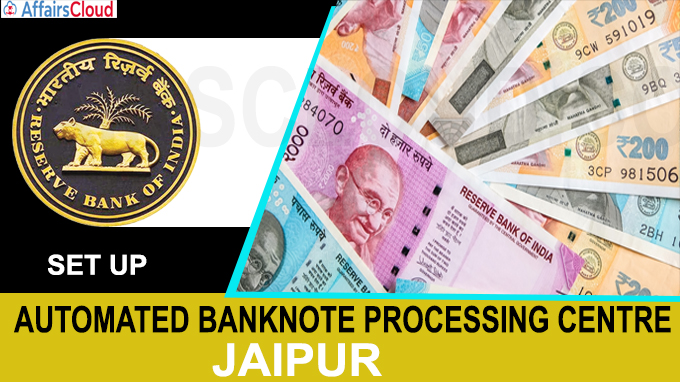 On December 13, 2020, Reserve Bank of India (RBI) has decided to set up an Automated Banknote Processing Centre (ABPC) in Jaipur, Rajasthan for automated receipt, storage of fresh banknotes received from the printing presses, and then retrieval and dispatch of these banknotes to the identified issue offices (IOs)/currency chests (CCs). The centre will also demolish destruction of soiled banknotes. This all process will be done in an automated manner.
On December 13, 2020, Reserve Bank of India (RBI) has decided to set up an Automated Banknote Processing Centre (ABPC) in Jaipur, Rajasthan for automated receipt, storage of fresh banknotes received from the printing presses, and then retrieval and dispatch of these banknotes to the identified issue offices (IOs)/currency chests (CCs). The centre will also demolish destruction of soiled banknotes. This all process will be done in an automated manner.
- This decision has been taken to effectively deal with increasing circulation of banknotes.
- Notably, volume of banknotes in circulation and supply of banknotes by the presses have increased three-fold from March 2001 to March 2019.
- It is expected to rise further in the coming years despite the rise in digital payments.
Capacity Requirements of ABPC:
The projected storage capacity requirements for the ABPC are as follows:
- Fresh note stock (daily average) at 1,883 million pieces during 2024-25; 2,950 million pieces during 2029-30; and 6,853 million pieces during 2039-40
- Soiled notes at 7,718 million pieces during 2024-25; 11,568 million pieces during 2029-30; and 27,757 million pieces during 2039-40.
- It should also hold a stock of about 15 days of soiled banknotes and provide commensurate processing and destruction capacities.
Recent Related News:
i.The Reserve Bank is all set to evaluate the impact of multi-media public awareness campaign ‘RBI Kehta Hai’, which was launched in 14 languages to educate public about good practices, regulations and initiatives in banking and financial sector.
ii.The Internal Working Group (IWG) of RBI which was formulated on June 12, 2020 to review extant ownership guidelines and corporate structure for Indian private sector banks has recommended an increase in the promoters’ stake in Private Banks to 26% from 15% of the paid-up voting equity share capital of the bank in 15 years.
Static Points:
–RBI is the sole issuer of banknotes and responsible for management of currency.
–RBI is supplied with banknotes from four printing presses at Nasik,Maharashtra (Western India), Dewas, Madhya Pradesh (Central India), Mysore, Karnataka (Southern India) and Salboni, West Bengal (Eastern India).
–The coins are also minted at four mints viz, Mumbai (Maharashtra), Hyderabad (Telangana), Kolkata (West Bengal) and NOIDA (New Okhla Industrial Development Authority), Uttar Pradesh.
–The new banknotes and coins are received at 19 IO’s of the RBI from where these are further distributed to about 3,300 CCs operated by scheduled banks. The CCs act as store houses.
–The unfit notes withdrawn from circulation are verified through a Currency Verification and Processing System (CVPS) and destroyed by shredding.




